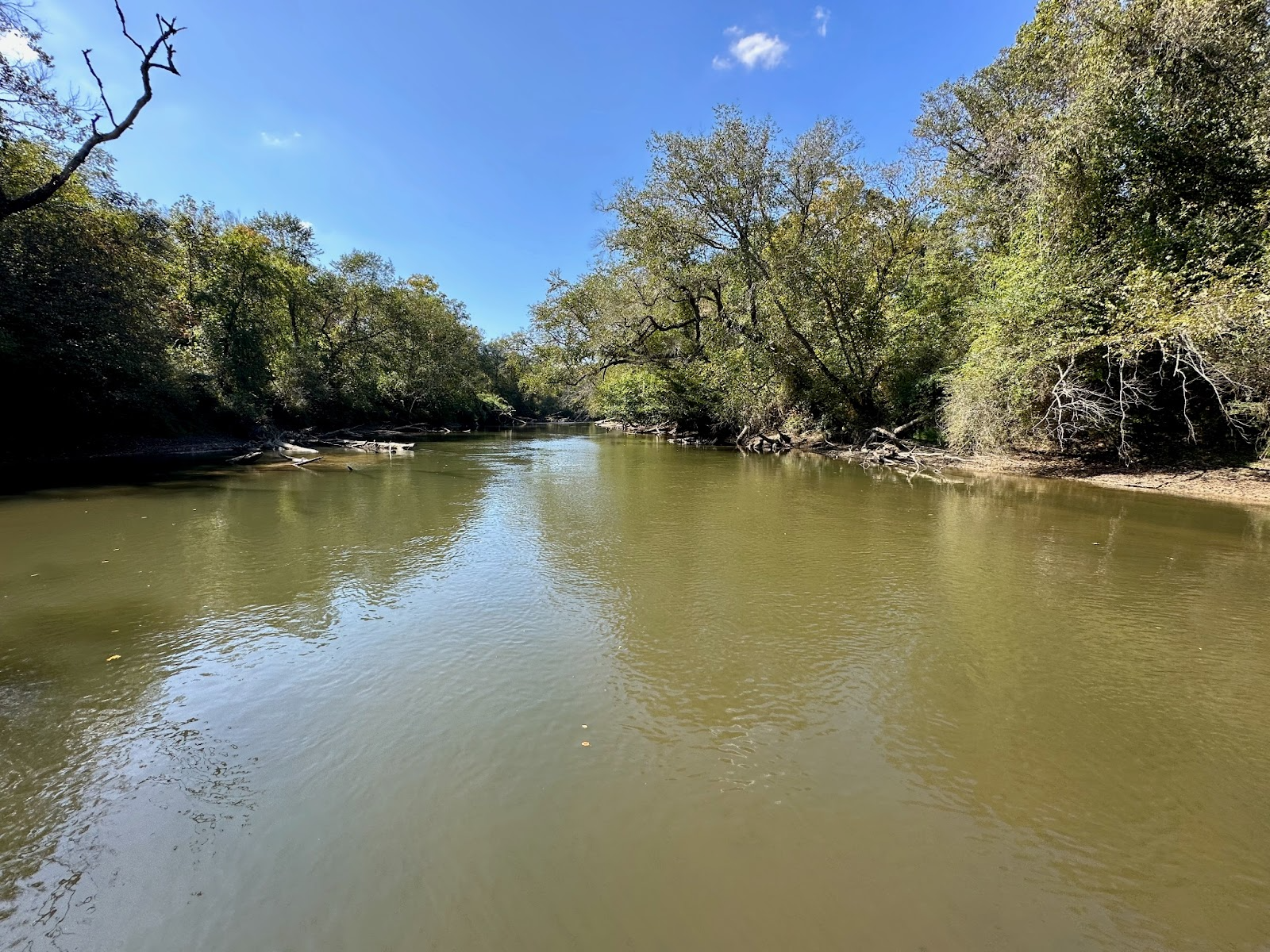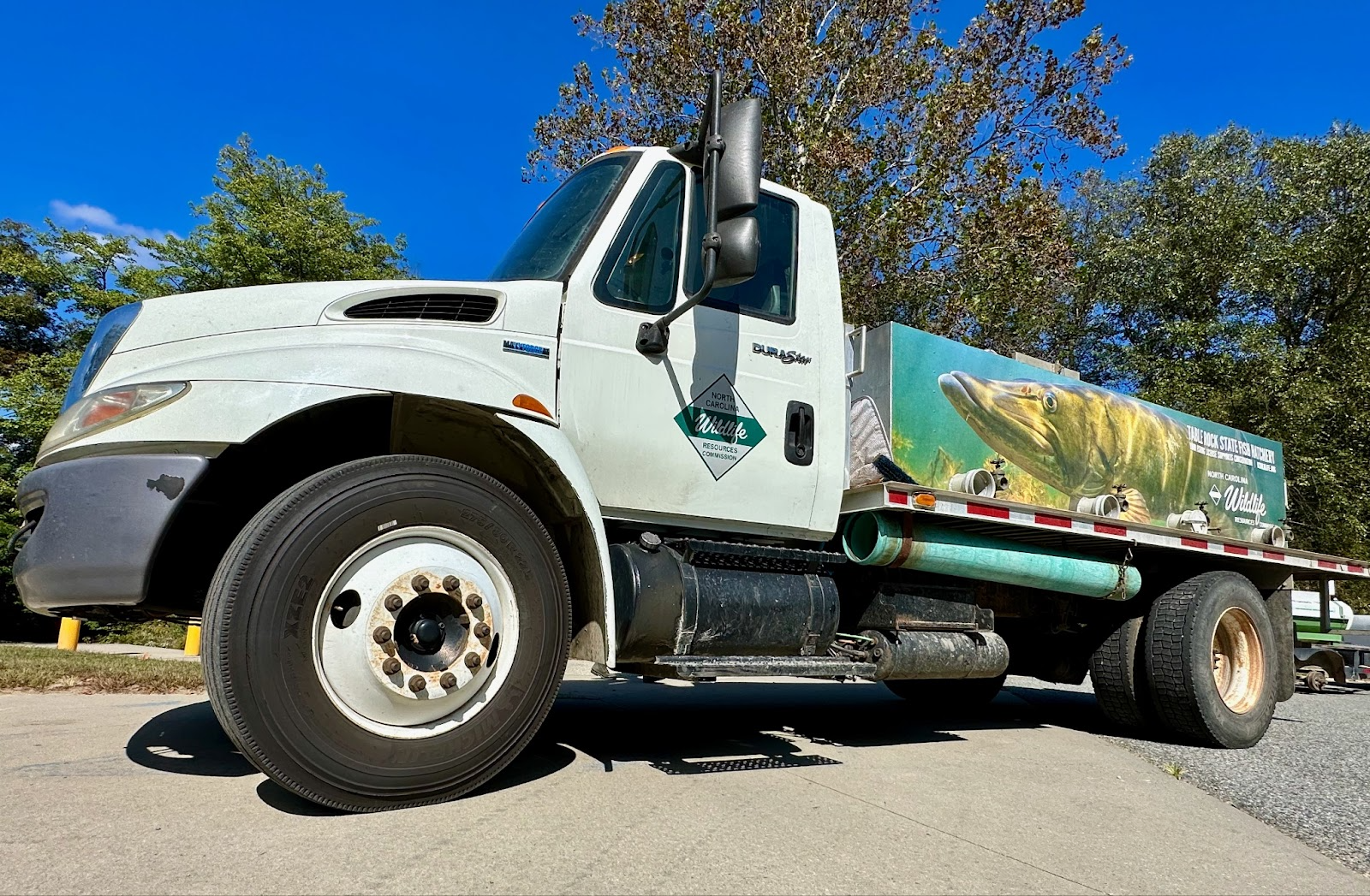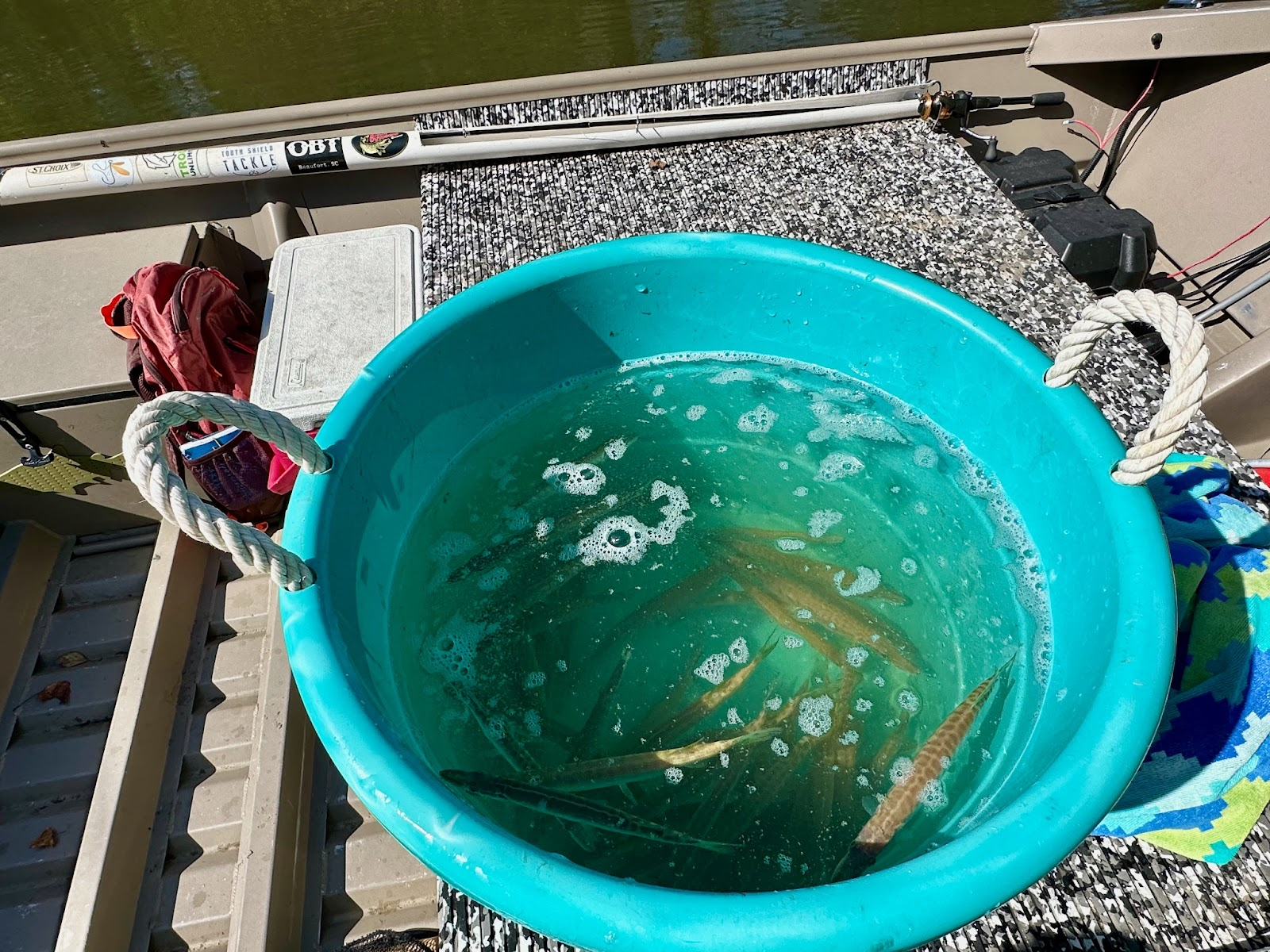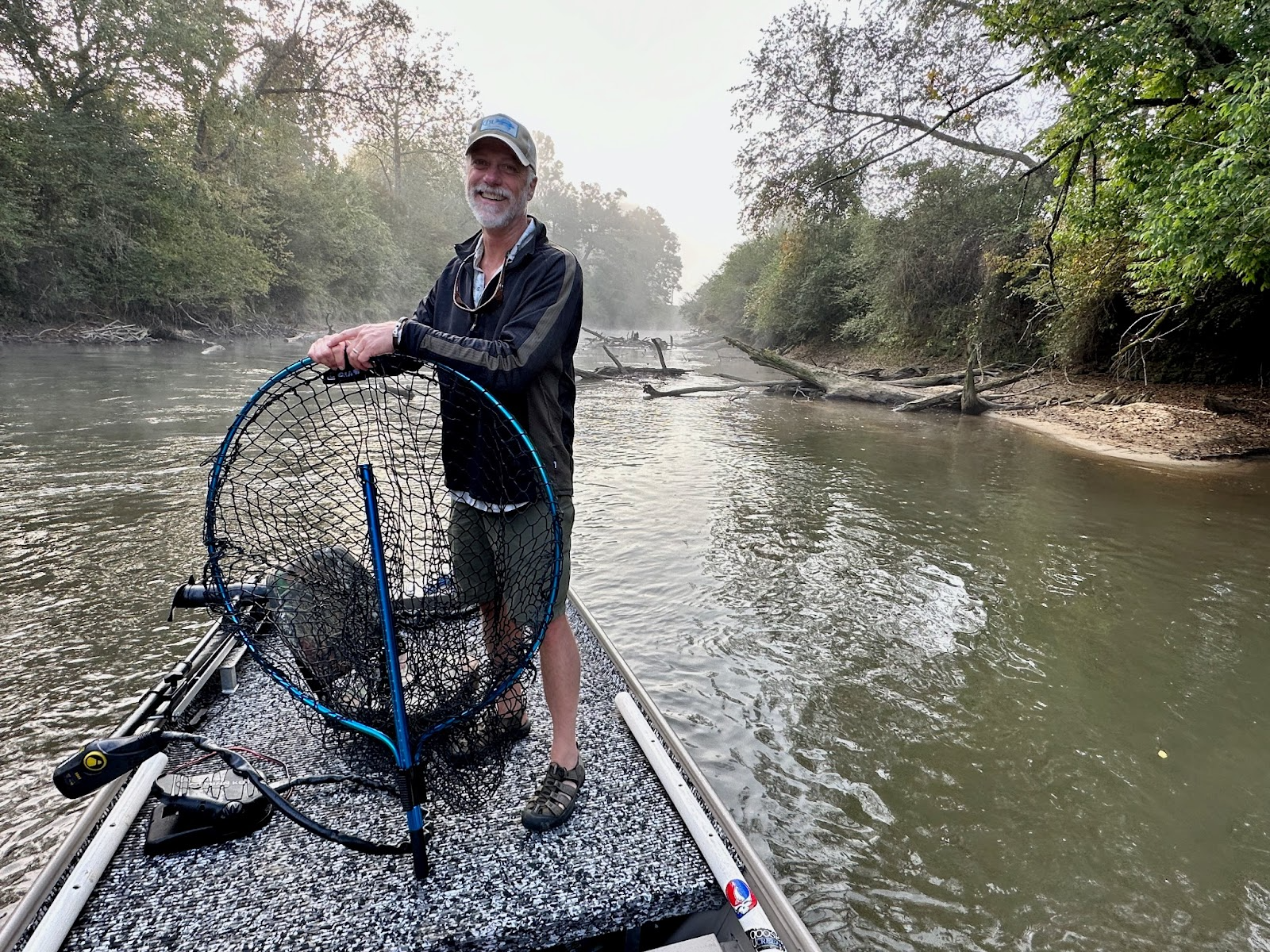The French Broad River that flows through North Carolina has some quirky features: it flows north, not south; it is one of the oldest rivers in the world and it is one of the southern-most waterways to have muskie, the common name for muskellunge. While northern states like Wisconsin are known for their large muskie, the cold mountain stream waters that feed into the French Broad River make it a prime habitat for these fish to thrive in North Carolina.
The muskie is one of the most prized fish to catch for anglers. This apex predator has a reputation as the fish of 10,000 casts because it is difficult to find and catch given that it is at the top of the food chain and has endless options for food eating when, and if, it feels like it. Muskies are exciting to catch and an impressive species to see up close.
While Tiger muskie are native to the French Broad River, their populations were mostly extinct by the early 20th century due to many years of land use farming and development changes to the landscape according to the North Carolina Wildlife Resources Commission. Factors like floodplain alteration, ditching and draining, and runoff from industrial chemical discharge into the river that had nowhere else to drain, decimated the muskie populations.
The biggest impact from these changes was that the backwater wetlands, or sloughs (pronounced “sloos”) where muskies spawn, were cut off from the main river system resulting in a ripple effect to the entire ecosystem.
“A slough is designed to hold grass allowing muskie to go up and spawn in it. It is where the egg fertilization takes place. It can adhere to the grass, and when they turn into to fry, they have a chance of a higher survivability because of the amount of vegetation that surrounds them,” said Stratton Hunter, owner of WNC Fish Hunter Guide Service and a long-time member of the Western North Carolina Muskie Club, told Kinute.
Without the sloughs, the muskies have no chance at long-term survival which is why a robust conservation program to restore muskie spawning habitats and populations is underway to make up for lost time.
The effort requires a multi-faceted approach to recreate sloughs and introduce muskie fingerlings each year along sections of the French Broad River near Hendersonville. These efforts are designed to give the species that are left the extra push they need to begin reproducing again naturally.

Muskie sloughs along the French Broad River. Photo provided by NCWRC
Building new spawning grounds
Slough creation for muskie spawning is a complex process that starts with a vision for environmental restoration and analyzing existing conditions. That assessment evaluates the options for floodplain restoration in areas that were once farmland along stretches of the French Broad River.Next steps involve engineering a design, permits for the project, selecting contractors for heavy equipment, and construction oversight. Once the sloughs are built, they require post project monitoring to evaluate their progress.
This multi-year and multi-agency effort to reestablish sloughs and reconnect these spawning grounds to the main river system began in 2020 with four of them now completed.
This Henderson County effort is a cooperative partnership between the North Carolina Wildlife Resources Commission and Conserving Carolina, a local nonprofit organization that requires meticulous planning and execution.
“The muskie sloughs that we are constructing along the French Broad River are slow moving backwater areas with a direct connection to the river,” said David Lee, natural resources manager for Conserving Carolina. “They are being constructed to mimic natural landscape features that don’t exist in the quality and quantity that they once did due to human development and agriculture in the French Broad River valley. These backwater features provide important sheltered habitat for aquatic and terrestrial species.”
While the end-goal is to provide essential spawning and nursery habitats for muskies, the sloughs have an even broader environmental impact with riparian buffer enhancements, groundwater recharge, flood reduction, sediment reduction, water treatment and aquatic habitat improvements.
“These features also contribute to the natural function of the larger floodplain system. When the river rises, it can more easily spill over onto the floodplain through these slough features,” said Lee.
While the sloughs are important to muskie project managers are finding an added benefit to other species in the French Broad River that are also utilizing the restored backwater areas. Animals like turtles, salamanders, ducks, frogs, songbirds, otters and other fish species that used to call these areas home are experiencing a comeback with the reestablished habitats.

A section of the French Broad River. Photo by Anietra Hamper
Sloughs and wetlands as top priorities
Conserving Carolina has many conservation projects in place impacting North Carolina’s trails, greenways, waterways and forests. The projects they undertake are mission-driven to protect land and water, care for nature and restore the natural world. While the muskie slough restoration project is just one of many for the organization, it is a top priority.
“Over the past 100-years, humans have substantially impacted the land next to the French Broad River which has resulted in poor water quality, increased flooding, and the loss/decline of important natural communities. The restoration work that Conserving Carolina is doing is directly addressing those issues while also incorporating the needs of our human community by providing and supporting recreational and educational opportunities, eco-tourism, health benefits, and other ecosystem services such as flood control and water quality improvement,” said Lee.
It is not practical to restore the floodplain of the entire river system because agriculture is necessary, but the current restoration model is a happy medium that accommodates both the natural and human worlds. The idea is that by making small improvements to many areas along the river, versus a more substantial overhaul, that it will result in a more dynamic river corridor.
With four sloughs completed, there are another three slated for development in 2024 with an eventual goal of establishing 50 acres of floodplain sloughs and wetland habitats that connect to the French Broad River.

NCWRC Muskie truck. Photo by Anietra Hamper
Boosting muskie populations
Aligned with habitat restoration, a second key component to this broad conservation effort for muskie is rehabilitating its population by stocking fingerlings each year. The North Carolina Wildlife Resources Commission (NCWRC) has been rearing and stocking muskies since 1970 in sections along the French Broad River.
“Muskies are raised at the NCWRC Table Rock State fish hatchery each year. Staff spawn adult musky each spring, around the first of April, and raise the fish indoors from eggs to the time they are stocked in October as one-inch fingerlings. We do not stock tiger musky. We use parent stock from the French Broad River and other surrounding water bodies, so a native lineage or strain,” said Scott Loftis, mountain aquatic habitat coordinator for the North Carolina Wildlife Resources Commission.

Stratton Hunter releases muskie fingerlings into the French Broad River. Photo by Anietra Hamper
When it is time for stocking the NCWRC muskie truck offloads fingerlings one bucket at a time along sections of the river. The 550 fingerlings distributed in 2023 were released five-to-seven at a time along the river’s edges. To aid in adequate distribution of the fingerlings, the NCWRC works with the Western North Carolina Muskie Club.
“They trust us in handling these baby muskie and it's just kind of a brilliant thing to be part of that. So, I think we have a lot to do with the restoration and rehabilitation of the muskie population in this river,” said Hunter.
The tiny muskies get acclimated to the water before swimming off to get settled into their new surroundings. The reality is that not all of them will make it into adulthood, but the hope is that enough of them will survive to eventually reproduce in the sloughs and provide new optimism for the musky population.

Muskie fingerlings ready for distribution. Photo by Anietra Hamper
To help with monitoring the progress of muskie survival and growth, fingerings that were stocked between 2018 and 2022 were tagged by the NCWRC with transponder chips for data collection. The tiny chips relay information to detection equipment about each fish including when it was stocked, its age, how much its grown since being tagged and verification of whether it was a hatchery reared fish or river spawned fish.
“The tagging of the fish also tells us if the muskie are using the restored floodplain sloughs, essentially verifying the use of the restored spawning and nursery habitat areas. Without the tagging component we would not know if the habitat restoration and floodplain connectivity projects were beneficial. So, we are learning a lot about muskie biology in addition to the use of the restored floodplain habitat,” said Loftis.
So far, the numbers are showing progress. The NCWRC estimates that the number of muskie in the river today is similar or possibly exceeds the population numbers prior to the human-caused declines nearly a century ago.
“We are currently working on a study to estimate population density and we should have a good handle on that in a year or so but from annual collection efforts we know the population is supported by an adequate number of adult and juvenile muskie,” said Loftis.
With the positive impact so far and continued monitoring, these conservation partners have better insights into how to support these muskie populations going forward.

Muskie fishing guide Stratton Hunter on the French Broad River. Photo by Anietra Hamper
Civilian support
Though federal, state, and local agencies are collaborating on the creation of muskie sloughs and funding for stocking, the success of these efforts requires the support of the people using the river system. This includes fishing guides like Stratton Hunter who regularly takes anglers onto the French Broad River to fish for muskie.
Hunter considers himself more than a guide and participant in the muskie habitat and population rehabilitation efforts, but also a conservation steward on the river. That means doing his part to give nature the best chance at a comeback by not scheduling fishing sessions in the spring months when the muskie should be spawning.
“We're trying to increase the numbers of muskie in this river because it's a win for everybody, right? It's a big, wonderful fish to catch. It helps the fishing population to grow, gets kids interested in fishing and it puts a magnificent fish back in the river system. There's probably an economic perspective to it as well. More people will start traveling here to fish, but hopefully they'll come with the right responsibility to understand and take care of these fish as well,” said Hunter.
The habitat and wetlands restoration projects are well received according to the NCWRC in part because they provide additional benefits to the local community that extend beyond just preserving the natural resources.
The measures of success are motivation enough to keep these projects going and moving conservation in the right direction. In doing so, restoring what was lost in nature because of human impact is now, in turn, having a different kind of impact on the human world.
“Partnerships and collaborations that are formed with key groups such as the local land conservancy, Conserving Carolina, in Henderson County is the current model for performing landscape scale restorations that ultimately sustain the natural world and provide areas for people to remain in touch with nature,” said Loftis.
In places like Mud Creek, one of the first sloughs and wetlands restoration projects on the French Broad River, plans are in the works to eventually create walking public trails around the newly created habitat. The natural elements that people will experience there is proof that true ecological restoration is possible. They will observe native plants that have replaced invasive species and birds, dragonflies and other animal species in the meadows that in the spaces of once abandoned farm fields.
As for the muskie that can now access these sloughs newly connected to the French Broad River, no one can ultimately predict what their future holds but the outlook has never been more optimistic. The odds continue tipping in their favor one muskie and one conservation effort at a time.
